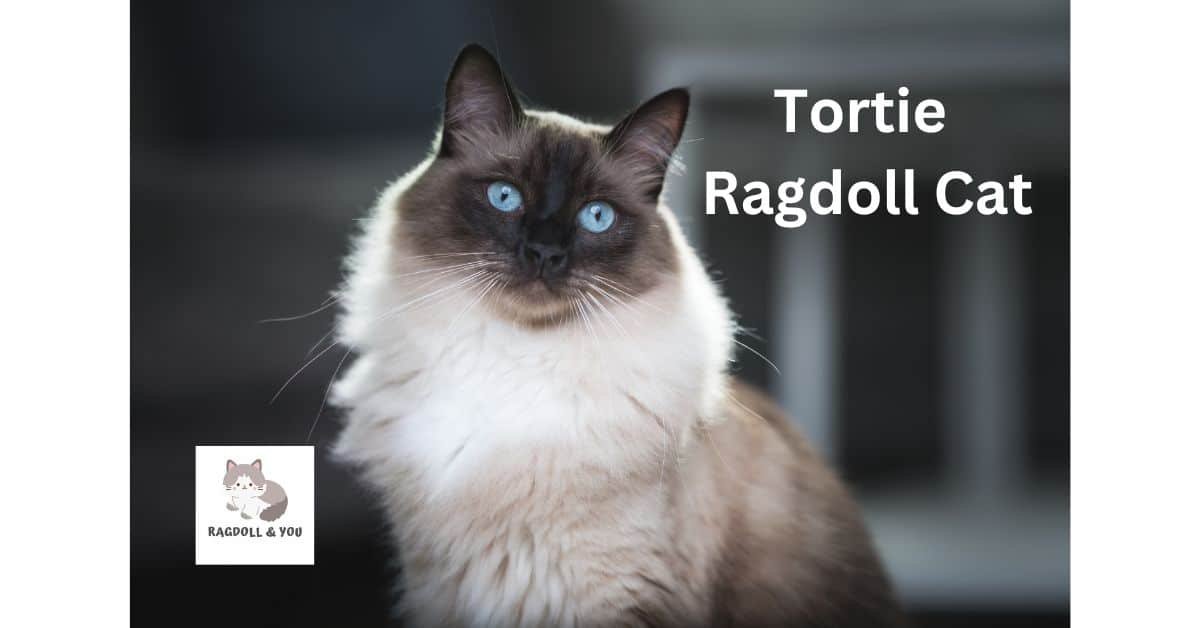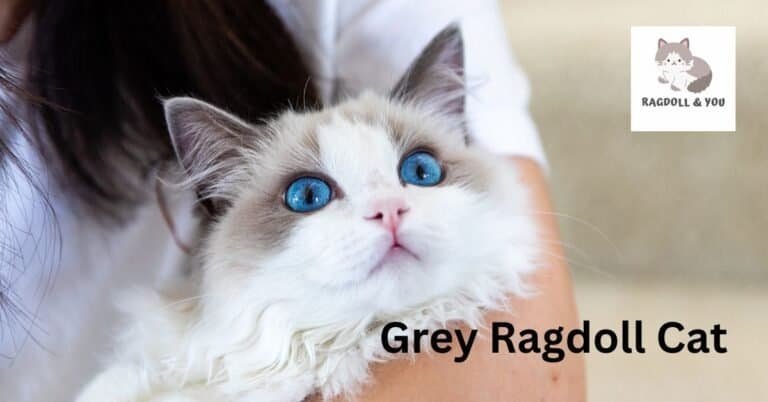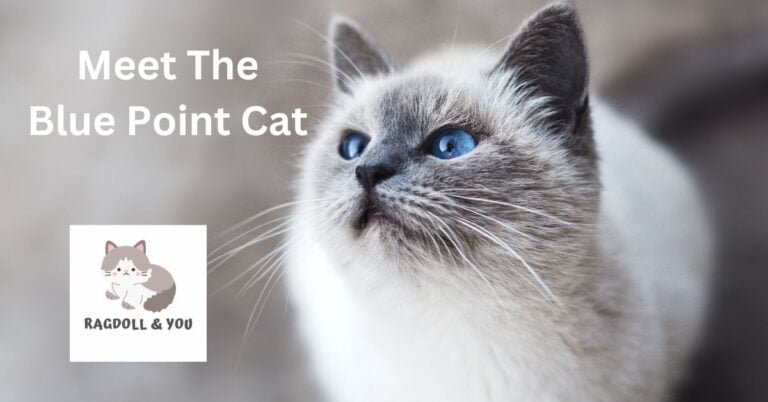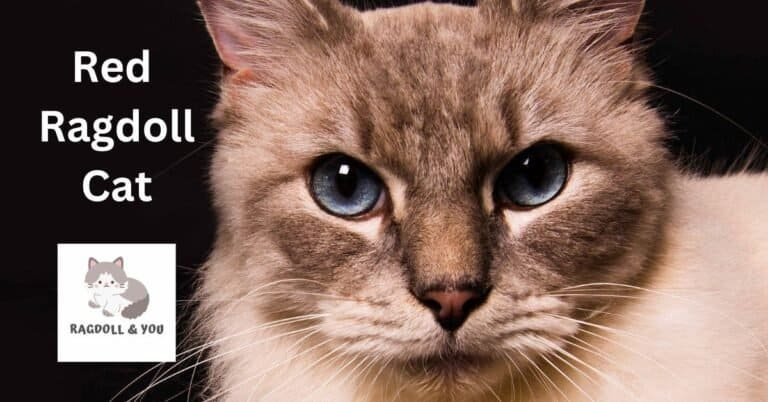Tortie Ragdoll: Ultimate Guide Of The Tortoise Shell Ragdoll
Have you recently stumbled upon the enchanting allure of a Tortie Ragdoll cat? Drawn in by its striking multi-colored coat and warm, affectionate nature? Trust me, I totally get it.
The same happened to me once when I first encountered this unique tortoiseshell-patterned ragdoll breed. With diligent research and countless hours spent understanding their quirks, I found fascinating tidbits like how they closely mimic the speckled shell of a tortoise!
This comprehensive guide is designed as your trusty encyclopedia – familiarizing you with everything from their historical lineage to daily upkeep needs.

What is a Tortie Ragdoll?
A Tortie Ragdoll is a unique and beautiful cat breed that combines the stunning coloring of a tortoiseshell cat with the gentle nature of a Ragdoll.
Breed Overview
Tortie Ragdolls are a special kind of cat. They have markings that look like the mottled shell of a tortoise. This is why they’re called “tortie.” Their coat blends two colors, often cream and dark splashes.
When you pick up a Tortie Ragdoll, it may go limp like an actual ragdoll! The body of this furry friend is long and muscular, with a wide chest and bushy tail. It fits within the standard for the Ragdoll breed.
Yes, Torties are indeed part of the much-loved Ragdoll family!
History of Tortie Ragdoll Cats
Tortie Ragdolls got their start back in the 1960s. A woman named Ann Baker was the first to breed them. She lived in California and loved cats very much.
Her aim was to make a cat with markings like a tortoise shell.
So, she picked out cats with special looks and traits for her plan. The Tortie Ragdoll is one of those types today. It has a long body that shows its might but is also gentle.
Its wide chest and bushy tail add charm to its look, while the medium-sized head sits on a thick ruff around its short neck.
These cats stand out because of their mottled pattern points, making each one unique!
Difference between Tortie and Calico
Tortie and Calico cats look alike, but they are not the same. A Tortie Ragdoll cat has two colors: black and orange or gray and orange.
They don’t have white on them at all! On the other hand, Calico cats show off three colors – black, orange, and white.
Some people use ‘Calico’ to talk about Torties. But that’s not right due to a lack of white in their coat color. So remember, both are Ragdoll cats differing only by their coat color patterns!
Tortie Ragdoll genetics
Tortie Ragdoll’s genetics is a fascinating topic. Let’s dive in! Tortie Ragdolls have a unique coat pattern called tortoiseshell coloring.
This means they have patches of different colors, like black, orange, and sometimes white.
But did you know that tortie cats are almost always female? It’s because the gene for their unique color pattern is linked to the X chromosome.
Male cats only have one X chromosome, so they rarely inherit the gene combination needed for tortoiseshell coloring.
In addition to their beautiful mottled fur, some Tortie Ragdolls may have Lynx point markings on their ears and face. By exploring cat genetics, we can predict the colors and patterns of each kitten before they’re even born.

Recognition by cat registries
Important cat registries like TICA and CFA recognize the Tortie Ragdoll cat. The CFA officially recognized the Ragdoll breed in 1998, which includes the beautiful Tortie Ragdolls.
These cat registries have specific breed standards that include Ragdolls with tortie points and white patches, making them a part of the recognized breed.
So, if you have a Tortie Ragdoll, you can be assured that they are acknowledged for their unique tortoiseshell pattern by these prestigious organizations.
While Tortie Ragdolls may not be considered rare within the larger Ragdoll breed, they stand out with their stunning coat colors and patterns!
The rarity of Tortie Ragdolls
Tortie Ragdolls are known for their unique and beautiful coat patterns, making them rare. These cats have a combination of two colors: black and orange.
The rarity comes from the genetic makeup that produces these distinctive markings.
Male Tortie Ragdolls, in particular, are incredibly scarce, with only about one in every 3,000 torties being male.
This is because the gene responsible for the tortoiseshell pattern is linked to the X chromosome, which males typically have only one of.
So, consider yourself lucky if you ever encounter a male Tortie Ragdoll!
Gender of Tortie Ragdolls
Tortie Ragdolls are special because they’re almost always female. The gene for their unique orange and black coat colors is on the X chromosome.
It’s very rare to find a male Tortie Ragdoll, with only about 1 in every 3,000 being male.
Male Torties often have health issues or may be sterile. So, if you’re looking for a Tortie Ragdoll, you’ll bring home a lovely lady cat!
Color variations in Tortie Ragdolls
Tortie Ragdolls come in a variety of beautiful color combinations. Here are some of the different color variations you can find in these cats:
- Red and black: Tortie Ragdolls have patches of red and black on their coat. These colors create a unique and striking pattern.
- Cream and red shades: Some Tortie Ragdolls have shades of cream and red on their coat. This combination adds warmth and depth to their appearance.
- Mottled markings: Tortie Ragdolls often have mottled markings on their head, tail, or paws. These speckles of color add an interesting texture to their fur.
- Dilute forms: Sometimes, Tortie Ragdoll’s coat colors may appear lighter or softer. This is known as the dilute form of tortoiseshell coloring.
In-depth Look at Ragdoll Colors
Ragdoll cats are known for their beautiful coat patterns and colors. Regarding Ragdoll colors, there are six distinct options: seal, chocolate, red, blue, lilac, and cream.
Each color can appear in variations and combinations on a Ragdoll’s coat. When we look at the tortie Ragdolls specifically, they have a unique pattern that combines two colors other than white.
The tortie Ragdoll has patches of red-based and black-based fur in its points. These patches can be closely mixed or appear in larger areas on their body.
It’s interesting to note that while tortoiseshell patterns are seen in many domestic short hairs (like calico cats), Ragdolls don’t often show such a pronounced variety of colors in their coats.
To better understand the coloration of a tortie Ragdoll cat, you can refer to a rag doll color chart. This chart shows that these cats have bodies with lots of cool whites while their pointed areas are adorned with deep gray tones.
This combination creates a stunning and unique look for each tortie Ragdoll.
In conclusion, the tortie pattern offers an exciting variation for those looking for something different regarding rag doll colors.
With its mix of red-based and black-based patches on a background of cool whites and deep grays, the tortie rag doll is truly one-of-a-kind.
Tortie Ragdoll Physical Appearance
The Tortie Ragdoll has captivating physical features like unique eye colors, a large and muscular body, and a luxurious coat with distinctive tortoiseshell markings.

Eye color
One of the distinctive features of Tortie Ragdoll cats is their eye color. While it can vary, blue eyes are quite common in this breed. Ragdolls, in general, are known for their bright, vivid blue eyes that can be pretty mesmerizing.
Whether they have a bluish-white or a platinum grey body, these beautiful cats often have deep blue-grey points mottled with cream. Traditional Ragdolls, which are pointed cats, also have blue eyes.
Tortie Ragdoll’s eyes’ varying shades of blue add to their unique and enchanting appearance.
Size, height, and weight
Tortoiseshell Ragdoll cats are known for their large size and muscular build. They have a wide chest and a long, bushy tail.
On average, they weigh between 10 to 20 pounds. Male Tortie Ragdolls tend to be larger than females.
In terms of height, Tortie Ragdolls can range from 9 to 13 inches tall. So, if you’re looking for a substantial feline companion, the Tortie Ragdoll is the perfect choice!
Coat colors and types
The Tortie Ragdoll cat has a unique and eye-catching appearance regarding coat colors and types. Here are some key facts about their coat variations:
- Tortie Ragdolls have tortoiseshell markings on their coats, which consist of orange, black, and yellow patches.
- The tortie pattern describes a combination of red-based and black-based patches in the points of the cat’s body, such as the ears, face, paws, and tail.
- The coat of a Tortie Ragdoll combines two colors other than white. These colors can either be closely mixed or appear in larger patches.
- Some common variations in coat patterns include tortie point (tortoiseshell with pointed coloration), tortie mitted (tortoiseshell with mittens), and tortie bicolor (tortoiseshell with white markings).
- A Tortie Ragdoll’s coat’s shades of orange, black, and yellow can vary from cat to cat. This gives each cat its unique look.
Tortie Ragdoll Personality and Care
Tortie Ragdolls are known for their sweet and gentle temperament, making them perfect family pets. They require regular grooming to maintain their beautiful coat and can benefit from consistent training and exercise.

Temperament and suitability as family pets
Tortie Ragdolls are known for their healthy and affectionate nature, making them great family pets. They are gentle and good-natured, always ready to shower love on their owners.
These cats are easy to train and enjoy the company of all family members, including children. They have a submissive temperament and get along well with other pets in the household.
Tortie Ragdolls are cuddlers who enjoy spending quality time with their owners, making them excellent companions for those seeking a loving feline friend.
These cats adapt well to different household setups, ensuring they fit into any home environment.
Training and exercise requirements
Training and exercising a Tortie Ragdoll is vital to keep them happy and healthy. Here are some tips:
- Use positive reinforcement methods to train your Tortie Ragdoll. Reward them with treats or praise when they follow commands or learn new tricks.
- Teach basic commands like “sit” and “stay” using repetition and rewards.
- Provide interactive toys and playtime activities to keep your Tortie Ragdoll mentally stimulated. They enjoy chasing toys, climbing cat trees, and playing with puzzle toys.
- Set up regular exercise routines for your Tortie Ragdoll. This can include interactive play sessions using toys or laser pointers and physical activities like agility training or supervised outdoor time if it’s safe.
- Make sure your Tortie Ragdoll has enough space to roam around and play. They enjoy exploring their environment, so provide scratching posts, climbing trees, and hiding spots for them to enjoy.
- Engage in regular playtime with your Tortie Ragdoll to build a strong bond and keep them active. Playful behavior helps them release energy and stimulates their natural hunting instincts.
Grooming and shedding
Caring for grooming and shedding is essential to owning a Tortie Ragdoll cat. Here are some important things to keep in mind:
- Tortie Ragdolls have a moderate amount of shedding compared to other thick-furred cats.
- Their shedding is not excessive because they lack a dense undercoat.
- Regular grooming is necessary to maintain a healthy and tangle-free coat.
- Neglecting to brush them can result in hair tangling and matting, leading to skin problems.
- Tortie Ragdolls have semi-long-haired, plush, silky coats that require regular grooming to prevent knots and tangles.
- Brushing their fur at least once or twice a week will help remove loose hair and prevent it from spreading around your home.
- Pay special attention to areas such as the belly, armpits, and behind the ears, where tangles are more likely to occur.
- Use a comb with wide teeth or a soft-bristle brush suitable for their long hair.
- Some owners also find it helpful to use grooming wipes or waterless shampoos between baths to keep their coats clean and fresh.
- Bathing should only be done when necessary using cat-friendly shampoo, making sure to rinse out all the soap afterward thoroughly.
- Regular nail trimming, ear cleaning, and dental care are essential to their grooming routine.

Hypoallergenic qualities
As a Tortie Ragdoll owner, I know that many people wonder about their hypoallergenic qualities. While no cat breed is completely hypoallergenic, Tortie Ragdolls are often considered more suitable for people with allergies than other breeds.
This is because they have less of the protein called Fel d 1 in their saliva and skin secretions, which is what triggers allergic reactions in humans.
However, it’s important to note that individual reactions can vary, so spending time with a Tortie Ragdoll is always recommended before bringing one home if you have allergies.
Owning a Tortie Ragdoll can still be enjoyable for those sensitive to allergens with proper grooming and keeping their environment clean.
Food and diet
Feeding your Tortie Ragdoll the right food is vital to keep them healthy and happy. Here are some essential points about their food and diet:
- Balanced diet: Provide a balanced diet with high-quality cat food formulated for their needs. Look for brands that offer complete nutrition with a mix of protein, fats, and carbohydrates.
- Protein-rich meals: Include protein sources like chicken, fish, or turkey in their meals. This helps support muscle development and overall health.
- Avoid overfeeding: Be mindful of portion sizes to prevent obesity. Follow the feeding guidelines provided by your veterinarian or on the cat food packaging.
- Fresh water: Always provide clean and fresh water for your Tortie Ragdoll to stay hydrated throughout the day.
- Treats in moderation: Giving your cat treats as rewards is fun, but be cautious not to overdo it. Treats should only make up a small portion of their daily calorie intake.
- Consult with a vet: If you have any concerns about your cat’s dietary needs or specific health conditions, consult with a veterinarian who can recommend the best diet plan.
Common health issues
As a Tortie Ragdoll owner, I want to share some vital information about the common health issues that these cats may experience. Here are some key things to keep in mind:
- Male tortoiseshell cats are extremely rare, occurring in only 1 in 3,000 cases.
- Male tortoiseshell cats are typically sterile or have health issues.
- Ragdolls, in general, can be prone to specific health issues, such as Hypertrophic Cardiomyopathy (HCM), Feline Lower Urinary Tract Disease (FLUTD), obesity, and other health problems.
Finding and Owning a Tortie Ragdoll
When finding and owning a Tortie Ragdoll, it’s essential to start by researching reputable breeders specializing in this unique cat breed.
Finding reputable breeders
When looking for a reputable breeder for a Tortie Ragdoll cat, it is vital to consider a few key factors. Here are some tips to help you in your search:
- Research online: Start by researching online and look for reputable breeders specializing in Ragdoll cats. Look for breeders who have good reviews and positive feedback from previous customers.
- Visit cat shows or events: Attend cat shows or events in your area where you can meet breeders in person. This will allow you to see their cats up close and talk to them about their breeding practices.
- Ask for recommendations: Reach out to local veterinarians or fellow Ragdoll cat owners and ask for recommendations on reputable breeders. They can provide valuable insights or connect you with trusted sources.
- Check certifications: Ensure the breeder is registered with recognized cat registries, such as The International Cat Association (TICA) or the Cat Fanciers’ Association (CFA). These certifications indicate that the breeder follows ethical breeding standards.
- Request health guarantees: Reputable breeders should provide health guarantees for their kittens, including documentation of vaccinations and genetic testing for any known hereditary diseases common in Ragdolls.
- Visit the cattery: Visit the cattery where the kittens are raised. This will allow you to assess the living conditions and ensure that the cats are well-cared for and socialized properly.
- Ask questions: Be bold and ask questions about the breeder’s breeding practices, how they socialize their kittens, and any additional support they offer after you bring your new kitten home.
Purchasing a Tortie Ragdoll kitten
If you’re interested in getting a Tortie Ragdoll kitten, finding a reputable breeder is important. Look for breeders who specialize in Ragdolls and have a good reputation.
Ensure they are registered with recognized cat registries and follow ethical breeding practices.
Consider the kitten’s price, as Tortie Ragdolls can be more expensive due to their rarity.
Remember that owning a Tortie Ragdoll has pros and cons – they have a gentle nature and unique coloring, but they may require regular grooming and can be prone to specific health issues.
Ultimately, decide if a Tortie Ragdoll is the right fit for your family and lifestyle before purchasing.
Price considerations
The cost of owning a Tortie Ragdoll cat can vary depending on where you live in the USA. Pet Ragdolls can range from $800 to $2000 for show breed Ragdolls.
The price may be influenced by factors such as the breeder’s reputation, bloodline quality, and geographic location.
When budgeting for a Tortie Ragdoll, it’s important to consider the initial purchase price and ongoing expenses like food, grooming, veterinary care, and supplies.
However, while price is an important consideration, it should not be the only factor when bringing a Tortie Ragdoll cat home.

Pros and cons of owning a Tortie Ragdoll
Owning a Tortie Ragdoll can be a rewarding experience, but like with any pet, it comes with its own set of benefits and challenges.
| Pros | Cons |
| They are known for their friendly and affectionate nature, making them excellent companions. | They can be independent, which may not suit households looking for a highly interactive pet. |
| Tortie Ragdolls are generally healthy cats with fewer breed-specific health issues. | Despite their overall health, they may still face common cat health issues leading to expensive vet bills. |
| Their captivating blue eyes and unique, multi-colored coat make them attractive pets. | Their unique coat also means they may require regular grooming to keep it in good condition. |
| They are relatively easy-going cats, making them suitable for most families. | As easy-going as they are, they still require regular exercise and mental stimulation to stay happy and healthy. |
| Tortie Ragdoll kittens are available for those interested in owning one. | The uniqueness and rarity of this breed variation can make it more expensive to purchase. |
Remember, owning a pet is a life-long commitment, so it’s crucial to thoroughly assess the pros and cons before deciding to add a Tortie Ragdoll to your family.
Is a Tortie Ragdoll right for you?
If you’re looking for a unique and beautiful cat with a playful personality, a Tortie Ragdoll might be the right choice. These cats have fur resembling the tortoiseshell patterns, with orange and black patches.
They are known for their patience and love for playtime, making them great companions, especially for kids.
Although some people believe that cats with tortoiseshell markings have distinct personalities, it’s important to note that scientific evidence is inconclusive.
Male Tortie Ragdolls are extremely rare, so finding a reputable breeder is essential if you’re interested in owning one of these special cats.
Consider your lifestyle and whether you can provide the care and attention these cats need before bringing one into your home.
Conclusion
In conclusion, the Tortie Ragdoll is a unique and beautiful cat breed with its tortoiseshell markings. Developed by Ann Baker in California, these cats have become popular for their friendly and affectionate nature.
While primarily seen in female cats, male Tortie Ragdolls are rare. Their mottled coat resembling a tortoise shell makes them excellent companions for families looking for an adoring and cuddly pet.

FAQs
1. What Is A Tortie Ragdoll?
A tortie ragdoll is a specific color pattern variation of the ragdoll cat breed, characterized by patches of red or orange and black or chocolate fur.
2. Are There Any Health Issues Associated With Tortie Ragdolls?
Tortie ragdolls do not have any specific health issues associated with their color pattern. However, like all cats, they can be prone to certain genetic conditions, so regular veterinary check-ups are essential.
3. How Big Do Tortie Ragdolls Typically Get?
Tortie ragdolls are known for their large size. They can reach an average weight of 10-20 pounds for males and 8-15 pounds for females.
4. What Is The Temperament Of A Tortie Ragdoll Like?
Tortoiseshell Ragdolls share the same friendly and docile temperament as other Ragdolls. They are generally known to be calm affectionate, and enjoy being around people.
5. Do I Need Special Grooming Routines For My Tortie Ragdoll?
Regular brushing is usually sufficient to keep your Tortie Ragdoll’s fur in good condition since they have semi-long hair that doesn’t mat easily; however, occasional additional grooming may be required during shedding seasons to control loose fur.







